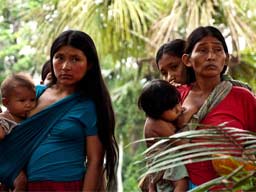Ivanhoe Energy
Block 20 – Drilling for Heavy Crude in the Sacred Valley
High above the tree line in the Andean páramo, the drops of water that will become the Misahualli river gather and join forces, beginning a dramatic decent to the Amazon Basin, carving canyons and shaping the landscape. Declared a "Valle Sagrado" by Ecuador's National Institute for Culture and Patrimony, this valley is indeed sacred. No doubt due to its warm climate, abundance of water, and fertile soil, the area has been home to indigenous peoples for thousands of years — some of whose cultural remnants are still seen today on dozens of petro-glyphs that date back to 10,000 years BC. In 2007, the Ecuadorian government gave Canada's Ivanhoe Energy drilling rights to a massive oil block, with the first wells slated for development alongside the Misahualli River in the heart of the Sacred Valley.
On the eastern side of this valley reside thousands of Kichwa indigenous people who still very much depend on the land and rivers for their daily survival. Grouped into seventeen communities are some 2,500 people who hold collective lands rights to thousands of acres of land known as Rucullacta, which means tierra antigua, or ancient land.
Ecuador's state oil company drilled exploratory wells here in the 1970s and found oil, but did not have the technology at the time to extract it. The crude in the underground formations is between 13° and 15° API — extremely heavy crude. According to justifications by Ecuadorian government, it granted the concession to Canada's Ivanhoe Energy due to its patented technology to convert the region's heavy oil into light oil (HTL technology), though many other companies still consider this to be a mining project, similar to the tar sands of western Canada. Given the extreme viscosity of the crude, the extraction process requires massive amounts of water, gas, and heat to suck it out of the rock and get it to flow in a pipeline.
The first well site underway on lands adjacent to Rucullacta, known as IP-15 in Nuevo Esperanza (New Hope), appears riddled with technical problems, though Ivanhoe press releases tout progress and good community relations. Ground reports from local communities, Amazon Watch field staff, and even some workers for Ivanhoe say that the company can't seem to get the tar like sludge out of the hole, is short on capital, and is currently looking for an investment partner.
According to Ivanhoe's press statements, the company has plans for dozens of wells inside Block 20, many which are slated for Rucullacta territory. In the face of this threat, Rucullacta held dozens of workshops and strategic meetings with leaders and allies. At Rucullacta's request, Amazon Watch traveled numerous times to help provide information on the project. Over the course of several months, five assemblies were held on the oil issue, and the community filed an injection to attempt to stop the project from moving forward.
On April 16th 2010, the communities held a massive, extra-ordinary assembly, with more than 1,000 people to come to consensus on their position regarding the oil project. Gathered in a sweltering coliseum and many carrying traditional hunting spears, community after community affirmed its opposition to the oil project. With unity among all of the Rucullacta communities, people took to the streets. Men, women, elders, and kids with signs, spears, and parasols marched some 5 km to the nearest town of Archidona. Walking down the main street, they headed to the Municipal building and the office of the Mayor. A public hearing was hastily arranged, Rucullacta leaders, backed by the President of Ecuador's all powerful national indigenous organization CONAIE and Amazonian confederation CONFENIAE, made their opposition to Ivanhoe, and all other oil, mining, and logging in the area explicit. To an outburst of applause and chants, the Mayor joined them, and publicly declared his opposition to the oil project.
An August 2010 press release from Ivanhoe reports disappointing results from the company's first exploratory well in Nuevo Esperanza and poor preliminary results from a second, which has led to company talk of conducting widespread seismic testing throughout the block. While this is a positive development for communities and shows that Ivanhoe's technology and analysis is questionable at best, it could open up large swaths of the block in search for lighter crude.






